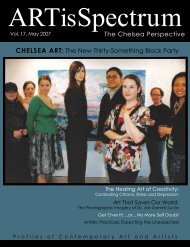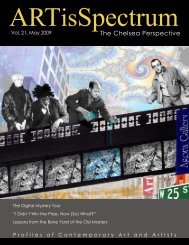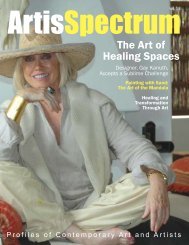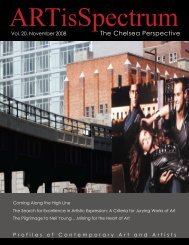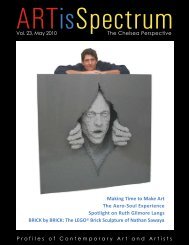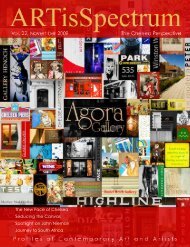Profiles of Contemporary Art and - ARTisSpectrum
Profiles of Contemporary Art and - ARTisSpectrum
Profiles of Contemporary Art and - ARTisSpectrum
Create successful ePaper yourself
Turn your PDF publications into a flip-book with our unique Google optimized e-Paper software.
sometimes undetectable to us; it is sometimes<br />
jarred into motion or beset by mutations<br />
or seminal moments that represent a<br />
radical break with the past <strong>and</strong> fast-forward<br />
us into someplace new <strong>and</strong> altogether remarkable.<br />
Within the striking <strong>and</strong> innovative<br />
series <strong>of</strong> forms spawned by Impressionism,<br />
one st<strong>and</strong>s out, by means <strong>of</strong> its influence<br />
<strong>and</strong> trenchant appeal in all <strong>of</strong> the long years<br />
in the aftermath <strong>of</strong> its inception – Cubism.<br />
In Cubism <strong>and</strong> Twentieth Century <strong>Art</strong>, Robert<br />
Rosenblum makes the case for Cubism<br />
in no uncertain terms: “There are moments<br />
in the history <strong>of</strong> art when the genesis <strong>of</strong> a<br />
new <strong>and</strong> major style becomes so important<br />
that it appears temporarily to dictate the<br />
careers <strong>of</strong> most individual artists. So it was<br />
around 1510, when the diverse geniuses <strong>of</strong><br />
Michelangelo, Raphael, <strong>and</strong> Bramante rapidly<br />
coalesced to create the monumental<br />
style <strong>of</strong> the High Renaissance; <strong>and</strong> around<br />
1870 when painters as unlike as Monet,<br />
Renoir, <strong>and</strong> Pissarro approached a common<br />
goal toward Impressionism. And so it<br />
was again around 1910, when two artists<br />
<strong>of</strong> dissimilar backgrounds <strong>and</strong> personalities,<br />
Picasso <strong>and</strong> Braque, invented the new<br />
viewpoint that has come to be known as<br />
Cubism.” Rosenblum’s words, published in<br />
1960, are no less enlightening today than<br />
they were then. Cubism represented a departure<br />
from the departure itself – Impressionism<br />
- blending form, perspective, reality,<br />
meaning, <strong>and</strong> intent together in such a<br />
way that art could still be based on sensual<br />
experiences <strong>of</strong> the natural world <strong>and</strong> yet be<br />
untied from conventional depictions <strong>of</strong> context<br />
<strong>and</strong> space, using metaphor <strong>and</strong> intellectual<br />
context in place <strong>of</strong> traditional depictions<br />
<strong>of</strong> visual context that had been based<br />
on a sense <strong>of</strong> place <strong>and</strong> time; creating a<br />
coherent reflection <strong>of</strong> an idea married to a<br />
formal integrity that led the viewer forever<br />
away from idealized historical allegory <strong>and</strong><br />
yet still found itself to be firmly grounded<br />
in the human condition.<br />
Ping He - HP008 Acrylic on Canvas 18” x 23”<br />
“The goal I proposed in making Cubism?<br />
To paint <strong>and</strong> nothing more... with a<br />
method linked only to my thought... Neither<br />
the good nor the true; neither the useful nor<br />
the useless.” ~Pablo Picasso.<br />
If it is true that the past is always present in<br />
art, no matter how indistinguishable or alien<br />
it might come to be depicted as in what<br />
comes after, it is true as well that Cubism<br />
always held within its grasp the future <strong>of</strong> art<br />
in the twentieth century. Going back was<br />
impossible - once unleashed, the energy<br />
represented by modern forms <strong>of</strong> art <strong>and</strong> the<br />
sometimes awful, always confounding, <strong>and</strong><br />
yet inspiring <strong>and</strong> richly diverse elements <strong>of</strong><br />
that art interwoven with parallel elements in<br />
twentieth century human history reached<br />
out to artists across the globe <strong>and</strong> broke<br />
down the barriers that had separated cultures,<br />
geographical regions, <strong>and</strong> class distinctions<br />
from each other in an older world<br />
now left behind by the passage <strong>of</strong> time.<br />
Even Cubism itself would find itself left<br />
behind by the onrush <strong>of</strong> artistic evolution<br />
<strong>and</strong> the accelerating pace <strong>of</strong> change that<br />
became as essential to artistic conception<br />
as the works themselves. Change begat<br />
change; <strong>and</strong> the idea that change could<br />
beget change drove illustrative <strong>and</strong> representational<br />
art into an endless metamorphosis;<br />
all the more so when the post-war<br />
consumer culture <strong>and</strong> the advent <strong>of</strong> electronic<br />
technology provided the imaginations<br />
<strong>of</strong> artists with a heady brew <strong>of</strong> subject <strong>and</strong><br />
context <strong>and</strong> tools that none could have<br />
imagined possible only a generation or two<br />
before. By the middle <strong>of</strong> the twentieth century,<br />
Action Painting, Pop <strong>Art</strong>, <strong>and</strong> Installa-<br />
51 <strong>ARTisSpectrum</strong>





